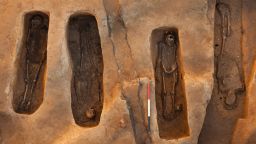Story highlights
Remains found of prominent Jamestown minister, explorer, governor's relatives
"They saw some of the most challenging times for Virginia's history and helped save the colony," scientist says
Scientists digging beneath the ruins of a historic church at the Jamestown settlement in Virginia have discovered the remains of four leaders from the earliest days of the British New World.
The first Anglican minister of the outpost, an explorer who rivaled John Smith, and relatives of the governor of colonial Virginia were among the men identified by researchers from the Smithsonian’s National Museum of Natural History and the Jamestown Rediscovery Foundation on Tuesday. The men were thought previously to have been lost to history after their deaths between 1608 and 1610.
The “extraordinary discovery” is a window into the beginning of American society, researchers say, and the result of years of detective work and brand new science.
“Being able to personalize their stories, they give us another way into looking at the remarkable history of these early years of English settlement,” said Dr. James Horn, a historian and president of the Jamestown Rediscovery Foundation, which has been excavating around the settlement for more than 20 years.
The Rev. Robert Hunt, an Anglican minister, and Capt. Gabriel Archer, an explorer, were on the first expedition from England that in 1607 established the colony of Jamestown, the first successful and permanent settlement in English America, researchers said.
They were found buried alongside Sir Ferdinando Wainman and Capt. William West, relatives of a colonial governor of Virginia, who arrived on a later expedition in 1610 intended to save the colony then crippled by famine and disease.
“They saw some of the most challenging times for Virginia’s history and helped save the colony and ultimately helped save English America,” Horn said.
The skeletons of the men were discovered in the chancel of the church, an area in the front of the structure, which would have been a burial spot reserved for only elite members of the community, the museum said.
Skeletons found holding hands after 700 years

Identifying the remains, which consisted of about 30% of each skeleton, was a feat nearly two years in the making.
Researchers first unearthed the remains in 2013 and used several lines of evidence to identify them, including chemical testing, genealogy, and even 3-D printing.
“It’s a major puzzle,” said Douglas Owsley, division head for physical anthropology at the Smithsonian National Museum of Natural History, describing the set of forensic and historical clues investigators pieced together to identify the skeletons.
Isotope testing on one set of bones found a significant level of lead, a sign the owner dined with finer pewter and glazed wares.
Micro-CT scans from around the grave site of another found highly decayed remnants of a military leader’s sash, likely made from silk and adorned with silver bullion fringe and spangles.
Hundreds of skeletons found under Paris supermarket
Horn said his team is 80% confident they’ve landed on the right four men, narrowed down from a list of dozens of candidates.
Buried along with the bones was a mystery, scientists said. Resting on a small piece of preserved wood from Archer’s coffin, diggers found a small silver box, believed to be a catholic reliquary.
“Really, really surprising,” Horn said of the sacred Catholic object, found beneath what is considered the first Protestant Church in the New World.
“Was he a secret Catholic? Does it mean religion was much more prominent in the early history of Jamestown then we may have thought?” Horn wondered.
“You have new evidence raising new questions about the history of our country. I think that’s where discoveries such as this have genuine impact,” he said.






